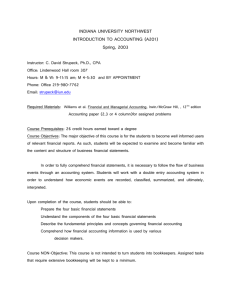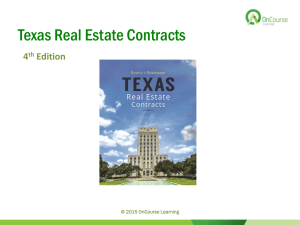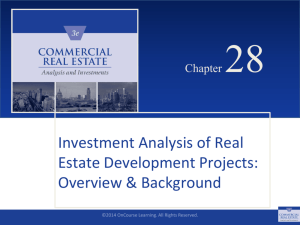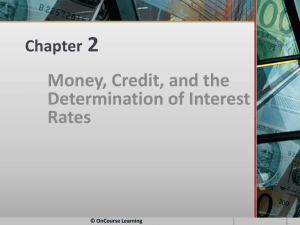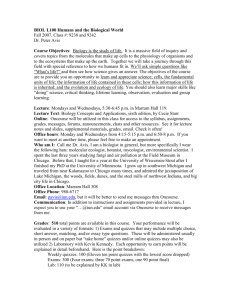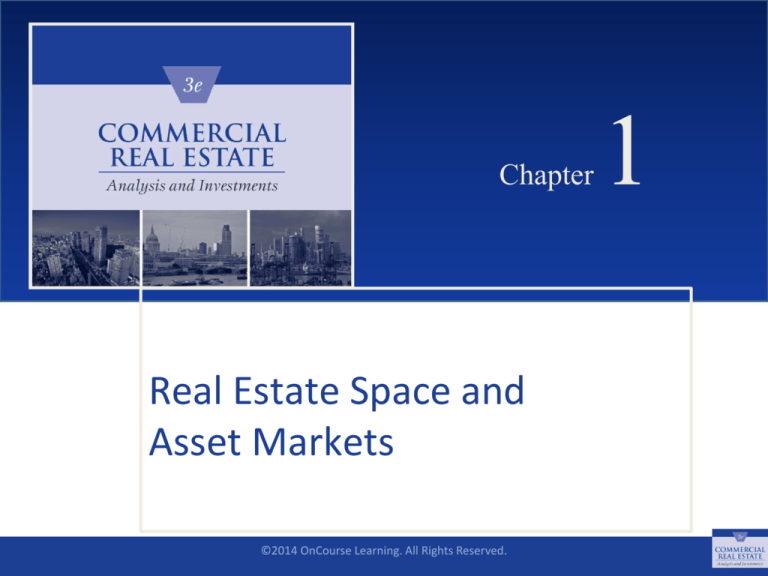
CHAPTER
1
Chapter
Real Estate Space and
Asset Markets
SLIDE 1
©2014 OnCourse Learning. All Rights Reserved.
1
CHAPTER
1
CHAPTER OUTLINE
1.1 Space Market
1.1.1
1.1.2
1.1.3
1.1.4
1.1.5
1.1.6
Segmentation of Space Markets: The Immobility of Real Estate
Supply, Demand, and Rent in the Space Market
Supply Is “Kinked”
Relation among Supply, Development Cost, and Rent
Forecasting the Future Direction of Rents
Is the Supply Function Rising, Level, or Falling?
1.2 Asset Market
1.2.1
1.2.2
1.2.3
1.2.4
Capital Markets
Magnitude of Real Estate Assets in the Overall Capital Market
Pricing of Real Estate Assets
Is the Asset Market Segmented Like the Space Market?
1.3 Chapter Summary
SLIDE 2
©2014 OnCourse Learning. All Rights Reserved.
CHAPTER
1
LEARNING OBJECTIVES
After reading this chapter, you should understand:
How to apply the basic economic concepts of supply and
demand to commercial real estate markets.
The difference between the real estate space and asset
markets.
The concept of market segmentation within the space market.
Why the long-run supply function in the space market is
“kinked” and what that means to future rents.
The difference between, and relative magnitudes of, the
public versus private asset markets, and the difference
between equity and debt capital.
What a cap rate is and what determines cap rate prevailing in
real estate markets.
SLIDE 3
©2014 OnCourse Learning. All Rights Reserved.
CHAPTER
1
1.1 Space Market
SLIDE 4
©2014 OnCourse Learning. All Rights Reserved.
1.1.1 Segmentation of Space Markets:
The Immobility of Real Estate
SLIDE 5
©2014 OnCourse Learning. All Rights Reserved.
CHAPTER
1
1.1.2 Supply, Demand, and Rent in the Space
Market
SLIDE 6
©2014 OnCourse Learning. All Rights Reserved.
CHAPTER
1
CHAPTER
1
Cincinnati Museum Center-Cincinnati Historical Society Library
Cincinnati skyline circa 1990
SLIDE 7
©2014 OnCourse Learning. All Rights Reserved.
CHAPTER
1
© OnCourse Learning
EXHIBIT 1-1 Office Demand as a Function of
Employment
SLIDE 8
©2014 OnCourse Learning. All Rights Reserved.
CHAPTER
1
© OnCourse Learning
EXHIBIT 1-2 Real Estate Space Market Supply
Function
SLIDE 9
©2014 OnCourse Learning. All Rights Reserved.
CHAPTER
1
1.1.3 Supply Is “Kinked”
SLIDE 10
©2014 OnCourse Learning. All Rights Reserved.
1.1.4 Relation among Supply, Development
Cost, and Rent
SLIDE 11
©2014 OnCourse Learning. All Rights Reserved.
CHAPTER
1
1.1.5 Forecasting the Future Direction
of Rents
SLIDE 12
©2014 OnCourse Learning. All Rights Reserved.
CHAPTER
1
CHAPTER
1
© OnCourse Learning
EXHIBIT 1-3 Change in Supply and Demand
and Rent over Time
SLIDE 13
©2014 OnCourse Learning. All Rights Reserved.
1.1.6 Is the Supply Function Rising, Level, or
Falling?
SLIDE 14
©2014 OnCourse Learning. All Rights Reserved.
CHAPTER
1
EXHIBIT 1-4 Long-Run History of Real Home Prices,
Building Costs, Population, and Interest Rates in the
United States
Source: Shiller, Robert J.; Irrational Exuberance, Second Edition. 2005 © Princeton
University Press. Reprinted by permission of Princeton University Press.
SLIDE 15
©2014 OnCourse Learning. All Rights Reserved.
CHAPTER
1
EXHIBIT 1-5 Manhattan Class A Office Market
Rents, 1988–2010 Nominal and Real
Source: Data from CBRE Econometrics.
SLIDE 16
©2014 OnCourse Learning. All Rights Reserved.
CHAPTER
1
CHAPTER
1
1.2 Asset Market
SLIDE 17
©2014 OnCourse Learning. All Rights Reserved.
CHAPTER
1
1.2.1 Capital Markets
SLIDE 18
©2014 OnCourse Learning. All Rights Reserved.
EXHIBIT 1-6 Major Types of Capital Asset
Markets and Investment Products
SLIDE 19
©2014 OnCourse Learning. All Rights Reserved.
CHAPTER
1
1.2.2 Magnitude of Real Estate Assets in
the Overall Capital Market
SLIDE 20
©2014 OnCourse Learning. All Rights Reserved.
CHAPTER
1
EXHIBIT 1-7 U.S. Capital Market Sectors,
a $70 Trillion Pie
Source: Authors’ estimates based on Miles and Tolleson (1997), updated with FRB statistics.
SLIDE 21
©2014 OnCourse Learning. All Rights Reserved.
CHAPTER
1
EXHIBIT 1-8 U.S. Investable Capital Market
with Real Estate Components Broken Out
Source: Based on Miles and Tolleson (1997), updated with FRB statistics.
SLIDE 22
©2014 OnCourse Learning. All Rights Reserved.
CHAPTER
1
CHAPTER
1
EXHIBIT 1-9A U.S. Commercial Property by
Physical Stock (billions of square feet) Total = 84
BSF (excluding Specialty/Entertainment)
Source: Based on Florance et al. (2010).
SLIDE 23
©2014 OnCourse Learning. All Rights Reserved.
EXHIBIT 1-9B U.S. Commercial Property by
Valuation ($ billions) Total = $9,173 billion
Source: Based on Florance et al. (2010).
SLIDE 24
©2014 OnCourse Learning. All Rights Reserved.
CHAPTER
1
CHAPTER
1
1.2.3 Pricing of Real Estate Assets
SLIDE 25
©2014 OnCourse Learning. All Rights Reserved.
1.2.4 Is the Asset Market Segmented Like the
Space Market?
SLIDE 26
©2014 OnCourse Learning. All Rights Reserved.
CHAPTER
1
© OnCourse Learning
EXHIBIT 1-10 Cap Rates (OARs) for
Commercial Property as of Third Quarter, 1994
SLIDE 27
©2014 OnCourse Learning. All Rights Reserved.
CHAPTER
1
EXHIBIT 1-11 Average Commercial Property
Transaction Cap Rates, 2001–2010
Source: Data from Real Capital Analytics Inc. used with permission.
SLIDE 28
©2014 OnCourse Learning. All Rights Reserved.
CHAPTER
1
CHAPTER
1
1.3 Chapter Summary
SLIDE 29
©2014 OnCourse Learning. All Rights Reserved.
CHAPTER
1
KEY TERMS
SLIDE 30
market
space market
usage market
rental market
demand
supply
rent
segmented markets
metropolitan areas (MSAs)
downtowns, CBDs
property usage type
kinked supply function
replacement cost
equilibrium rent
cap rate
location rent
centrality
asset market
property market
capital market
public markets
liquidity
informational efficiency
private markets
whole assets
debt
underlying assets
equity
capitalization (cap) rate
overall rate (OAR)
current yield
©2014 OnCourse Learning. All Rights Reserved.

